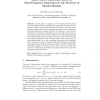Free Online Productivity Tools
i2Speak
i2Symbol
i2OCR
iTex2Img
iWeb2Print
iWeb2Shot
i2Type
iPdf2Split
iPdf2Merge
i2Bopomofo
i2Arabic
i2Style
i2Image
i2PDF
iLatex2Rtf
Sci2ools
ICA
2010
Springer
2010
Springer
Blind Source Separation Based on Time-Frequency Sparseness in the Presence of Spatial Aliasing
In this paper, we propose a novel method for blind source separation (BSS) based on time-frequency sparseness (TF) that can estimate the number of sources and time-frequency masks, even if the spatial aliasing problem exists. Many previous approaches, such as degenerate unmixing estimation technique (DUET) or observation vector clustering (OVC), are limited to microphone arrays of small spatial extent to avoid spatial aliasing. We develop an offline and an online algorithm that can both deal with spatial aliasing by directly comparing observed and model phase differences using a distance metric that incorporates the phase indeterminacy of 2 and considering all frequency bins simultaneously. Separation is achieved using a linear blind beamformer approach, hence musical noise common to binary masking is avoided. Furthermore, the offline algorithm can estimate the number of sources. Both algorithms are evaluated in simulations and real-world scenarios and show good separation performance....
Blind Source Separation | ICA 2010 | Signal Processing | Spatial Aliasing | Time-frequency Sparseness |
| Added | 09 Nov 2010 |
| Updated | 09 Nov 2010 |
| Type | Conference |
| Year | 2010 |
| Where | ICA |
| Authors | Benedikt Loesch, Bin Yang |
Comments (0)

